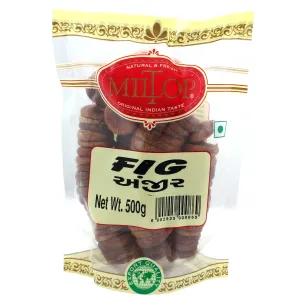Description
Figs are the pear-shaped false fruits of the fig tree. They contain large numbers of tiny stone fruits inside them. They are preserved by drying (dried fruit). The fig tree, which is often more bush-like, is native to the Persian Gulf and the Mediterranean. It is now widespread throughout the tropics and subtropics. The drying process flattens the figs, resulting in the loss of their pear-like shape and the adoption of around shape. Depending on quality, a distinction is drawn between natural figs and processed figs: Natural figs are dried in the sun or by machine, threaded on cords or into rings. The glucose which crystallizes out and creates a dull surface with its granules preserves the figs naturally as dried fruit. Processed figs undergo several operations, i.e. drying, immersion in salt water or steam treatment, pressing and then drying again. Pressing into particular shapes (slabs, rolls) and processing give the figs an attractive, shiny appearance. Figs processed in this way are commercially the most desirable.
The latex is widely applied on warts, skin ulcers and sores, and taken as a purgative and vermifuge, but with considerable risk. In Latin America, figs are much employed as folk remedies. A decoction of the fruits is gargled to relieve sore throat; figs boiled in milk are repeatedly packed against swollen gums; the fruits are much used as poultices on tumors and other abnormal growths. The leaf decoction is taken as a remedy for diabetes and calcifications in the kidneys and liver. Fresh and dried figs have long been appreciated for their laxative action. It is helpful in urinary disorders because it melt small stones. It is helpful in burn ulcers, build resistance, in hyperacidity, treating anaemia – Due to the iron-rich content of fig. It is also used in worm infestation – The enzyme ficin present in the fig latex is responsible for its anthelmintic activity and can be given with great benefit in worm infestations especially ascaris and tricharus types.
Figs should be large, thin-skinned and light brown and taste sweet, juicy and honey-like and often served with cream and sugar. Peeled or unpeeled, the fruits may be merely stewed or cooked in various ways, as in pies, puddings, cakes, bread or other bakery products, or added to ice cream mix. Home owners preserve the whole fruits in sugar syrup or prepare them as jam, marmalade, or paste. Fig paste (with added wheat and corn flour, whey, syrup, oils and other ingredients) forms the filling for the well known bakery product, “Fig Newton”. The fruits are sometimes candied whole commercially.
Dried cull figs have been roasted and ground as a coffee substitute. In Mediterranean countries, low-grade figs are converted into alcohol. An alcoholic extract of dried figs has been used as a flavoring for liqueurs and tobacco.



